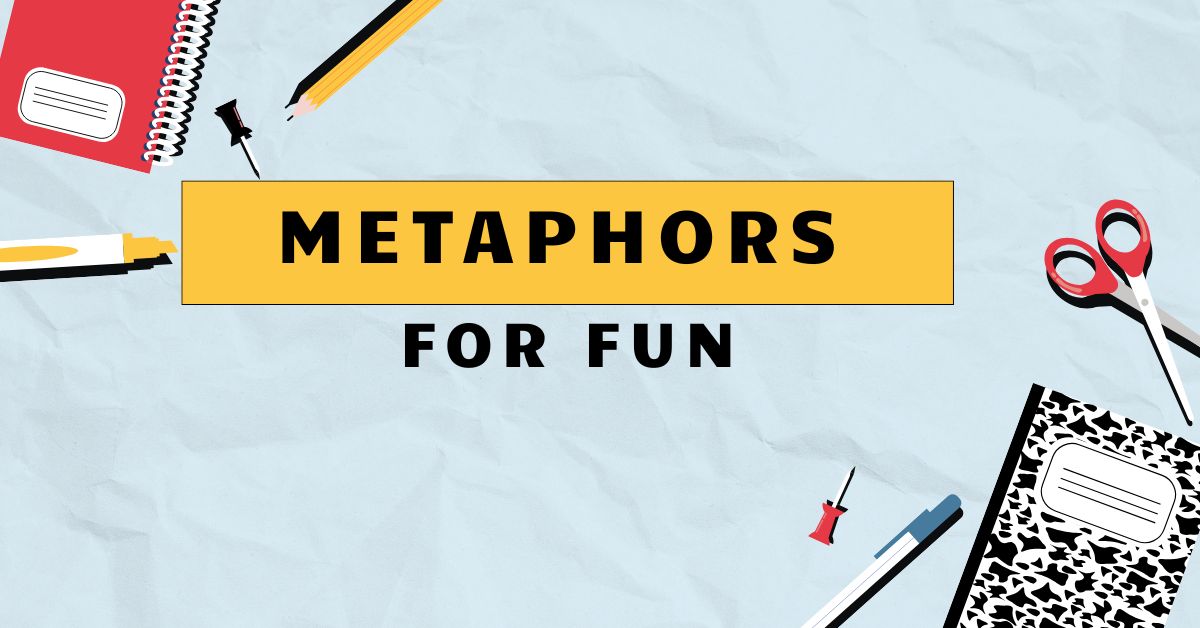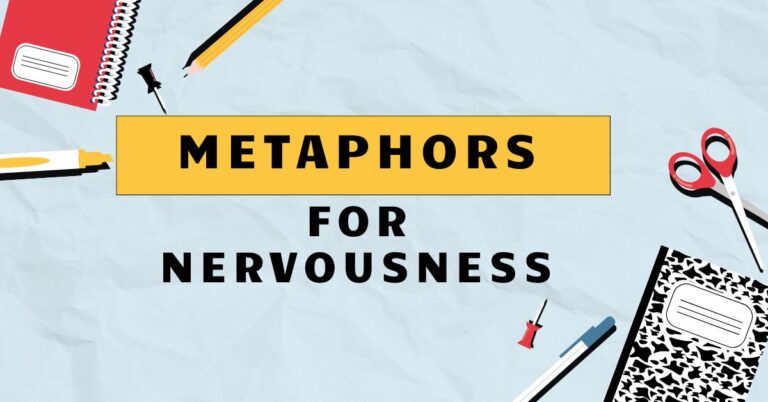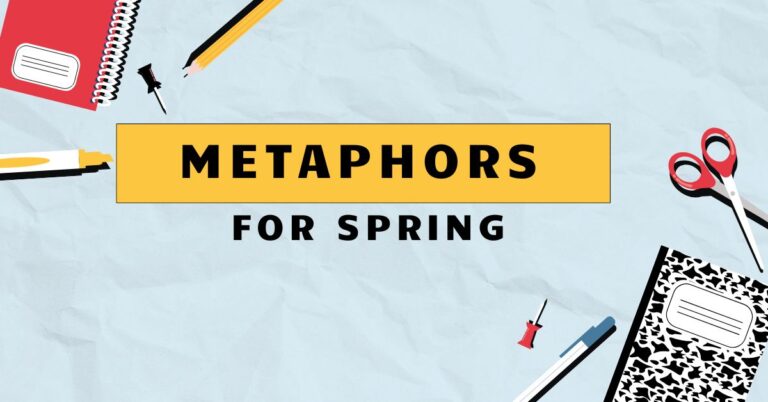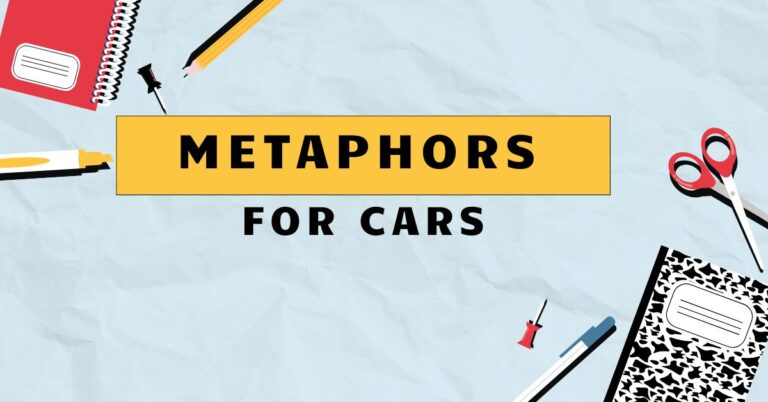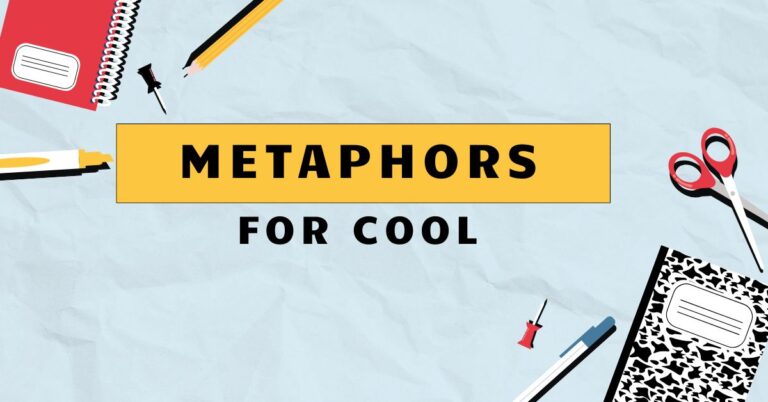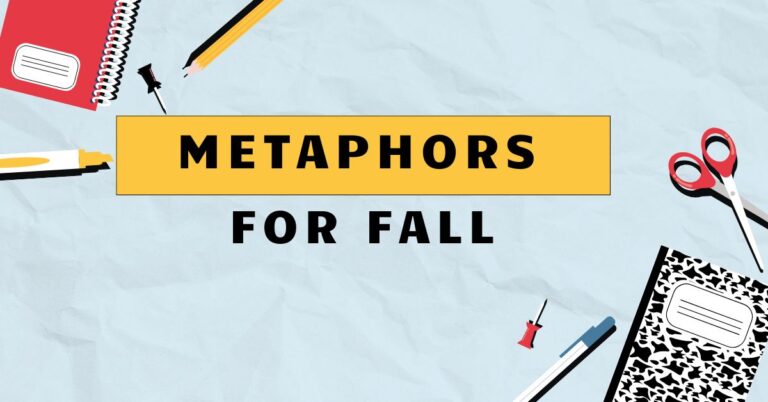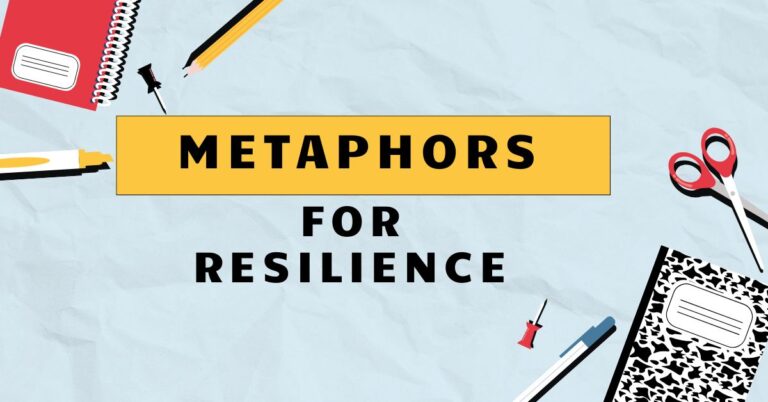47 Metaphors for Fun: Unlocking the Power of Figurative Language
Metaphors are a cornerstone of expressive language, allowing us to connect seemingly unrelated concepts and create vivid imagery. Understanding metaphors is crucial for interpreting literature, enhancing communication, and adding depth to our writing.
This article provides a comprehensive guide to metaphors, covering their definition, types, usage, and common pitfalls. Whether you’re a student, writer, or language enthusiast, this guide will equip you with the knowledge to effectively utilize and appreciate the power of metaphors.
Table of Contents
- Definition of Metaphor
- Structural Breakdown of a Metaphor
- Types of Metaphors
- Examples of Metaphors
- Usage Rules for Metaphors
- Common Mistakes with Metaphors
- Practice Exercises
- Advanced Topics in Metaphors
- Frequently Asked Questions
- Conclusion
Definition of Metaphor
A metaphor is a figure of speech that directly compares two unlike things without using “like” or “as.” It asserts that one thingisanother, creating a relationship based on shared characteristics or qualities. The purpose of a metaphor is to illuminate a concept, evoke emotions, or add stylistic flair to communication.
Metaphors enrich our understanding by presenting familiar ideas in new and imaginative ways.
Unlike similes, which use explicit comparison words, metaphors create a more implicit and impactful connection between the two subjects. For example, instead of saying “He is like a lion,” a metaphor would state “He is a lion.” This direct assertion lends a stronger sense of conviction and immediacy to the image.
The power of a metaphor lies in its ability to transfer qualities from one thing to another. This transfer allows us to perceive the target subject in a fresh and insightful manner.
Metaphors are not merely decorative; they are fundamental to how we understand and express complex ideas.
Structural Breakdown of a Metaphor
Understanding the structure of a metaphor involves recognizing its key components. These components work together to create the intended meaning and impact.
Analyzing these elements can help you to both deconstruct and construct effective metaphors.
The core elements of a metaphor are the tenor and the vehicle. Thetenoris the subject being described or explained.
It is the underlying concept or idea that the metaphor seeks to illuminate. Thevehicleis the object or concept used to represent the tenor.
It carries the qualities and associations that are transferred to the tenor.
Another important aspect is theground, which refers to the shared characteristics or qualities between the tenor and the vehicle. The ground is the basis upon which the comparison is made.
It’s the common ground that makes the metaphor meaningful and understandable.
For example, in the metaphor “Time is a thief,” “time” is the tenor, “thief” is the vehicle, and the shared characteristic of stealing (either possessions or moments) is the ground. Recognizing these elements allows for a deeper appreciation of the metaphor’s effectiveness.
Types of Metaphors
Metaphors come in various forms, each with its own characteristics and impact. Understanding these different types can help you to select and utilize metaphors more effectively in your writing and communication.
Standard Metaphors
Standard metaphors are the most common type, involving a straightforward comparison between two unlike things. They are typically concise and easily understood.
These metaphors are often used to add color and emphasis to writing and speech.
For example, “The world is a stage” is a standard metaphor that compares the world to a theater, suggesting that people are actors playing their roles. Similarly, “Life is a journey” compares life to a trip, highlighting its progression and experiences.
Extended Metaphors
An extended metaphor is a metaphor that is developed over several lines or even an entire work. It expands upon the initial comparison, exploring various aspects and implications.
Extended metaphors create a richer and more complex image in the reader’s mind.
Emily Dickinson’s poem “Hope is the thing with feathers” is a famous example of an extended metaphor. Throughout the poem, she develops the comparison between hope and a bird, exploring its resilience, comfort, and constant presence.
Mixed Metaphors
Mixed metaphors combine two or more incompatible metaphors in a single expression. This often results in a nonsensical or humorous effect.
While sometimes used intentionally for comedic purposes, mixed metaphors are generally considered a writing error.
An example of a mixed metaphor is “Let’s nip it in the bud before it snowballs.” This combines the metaphor of stopping something early (“nip it in the bud”) with the metaphor of something growing uncontrollably (“snowballs”). The combination creates a confusing and illogical image.
Dead Metaphors
Dead metaphors are metaphors that have become so common and overused that they have lost their original figurative meaning. They are often used without conscious awareness of their metaphorical origin.
These metaphors have become integrated into everyday language.
Examples of dead metaphors include “the leg of a table,” “the eye of a needle,” and “falling in love.” These expressions were once imaginative comparisons, but they are now used literally to describe those objects or experiences.
Conceptual Metaphors
Conceptual metaphors are underlying metaphors that shape our understanding of abstract concepts. They are often unconscious and pervasive, influencing how we think and talk about the world.
These metaphors are fundamental to human cognition.
For example, the conceptual metaphor “ARGUMENT IS WAR” influences how we frame and discuss arguments. We often use war-related language when talking about arguments, such as “He attacked my points,” “I defended my position,” and “We won the argument.”
Examples of Metaphors
This section provides a wide range of examples of metaphors, categorized for clarity. Each example illustrates the power and versatility of metaphorical language.
The tables below offer a structured way to explore different types of metaphors and their usage.
The following table presents examples of standard metaphors, showing how they create direct comparisons between unrelated concepts to add depth and imagery to writing.
| Metaphor | Explanation |
|---|---|
| Her smile was the sun. | Her smile is being compared to the sun, suggesting it was bright, warm, and radiant. |
| The city is a jungle. | The city is being compared to a jungle, implying it is chaotic, dangerous, and competitive. |
| Time is a river. | Time is being compared to a river, suggesting its constant flow and unstoppable nature. |
| He is a night owl. | He is being compared to a night owl, indicating he is most active at night. |
| She is a walking encyclopedia. | She is being compared to an encyclopedia, implying she has a vast knowledge of many subjects. |
| The internet is an information superhighway. | The internet is being compared to a highway, suggesting it provides fast and easy access to information. |
| My heart is a lonely hunter. | My heart is being compared to a hunter, suggesting it is constantly searching for love or connection. |
| His words were a knife. | His words are being compared to a knife, implying they were sharp, cutting, and hurtful. |
| The classroom was a zoo. | The classroom is being compared to a zoo, suggesting it was chaotic and unruly. |
| Life is a roller coaster. | Life is being compared to a roller coaster, highlighting its ups and downs, excitement, and unpredictability. |
| The politician is a snake. | The politician is compared to a snake, implying craftiness and untrustworthiness. |
| Her anger was a volcano. | Her anger is likened to a volcano, suggesting it was explosive and destructive. |
| He’s a shining star. | He is compared to a star, indicating brilliance and prominence. |
| The project was a nightmare. | The project is compared to a nightmare, suggesting it was unpleasant and stressful. |
| She is an angel. | She is compared to an angel, implying purity and kindness. |
| The contract is a minefield. | The contract is compared to a minefield, suggesting hidden dangers and risks. |
| His memory is a steel trap. | His memory is compared to a steel trap, indicating its strength and reliability. |
| The music was a wave of emotion. | The music is compared to a wave, suggesting its powerful and overwhelming effect. |
| Their relationship is a garden. | Their relationship is compared to a garden, suggesting it requires care and nurturing. |
| The test was a breeze. | The test is compared to a breeze, indicating it was easy and effortless. |
| Ideas are seeds. | Ideas are compared to seeds, suggesting potential for growth and development. |
| Books are mirrors. | Books are compared to mirrors, implying they reflect ourselves and the world around us. |
| Laughter is the best medicine. | Laughter is compared to medicine, suggesting its healing and beneficial effects. |
| Children are our future. | Children are directly identified as the future, emphasizing their importance. |
| He is the black sheep of the family. | He is compared to a black sheep, suggesting he is different and stands out. |
| Her heart is gold. | Her heart is compared to gold, implying it is precious and valuable. |
| The company is a sinking ship. | The company is compared to a sinking ship, suggesting it is failing and in danger. |
| The news was a bombshell. | The news is compared to a bombshell, indicating its shocking and unexpected nature. |
| He is a rock. | He is compared to a rock, implying strength and stability. |
The table below provides examples of extended metaphors. These metaphors are developed over multiple sentences or even paragraphs, creating a more detailed and complex comparison.
| Metaphor | Explanation |
|---|---|
| “All the world’s a stage, And all the men and women merely players; They have their exits and their entrances, And one man in his time plays many parts.” – William Shakespeare | This extended metaphor compares the world to a stage and people to actors, suggesting that life is a performance with different roles. |
| “Hope is the thing with feathers – That perches in the soul – And sings the tune without the words – And never stops – at all -” – Emily Dickinson | This extended metaphor compares hope to a bird, highlighting its resilience, constant presence, and ability to provide comfort even in difficult times. |
| “Life’s but a walking shadow, a poor player That struts and frets his hour upon the stage, And then is heard no more. It is a tale Told by an idiot, full of sound and fury, Signifying nothing.” – William Shakespeare | This extended metaphor compares life to a shadow and a poorly acted play, emphasizing its fleeting and ultimately meaningless nature. |
| “The road was a ribbon of moonlight.” | This metaphor can be extended by describing the texture, the way it winds, and the journey along it, deepening the sense of mystery and beauty. |
| “My life is an open book. Each chapter reveals a different adventure, a new lesson learned, and a deeper understanding of myself. Some pages are filled with joy and laughter, others with sorrow and tears. But every word, every sentence, tells a story of growth and resilience.” | This extended metaphor likens life to an open book, with each chapter representing a different phase and experience. |
| “Friendship is a sheltering tree. Its roots run deep, providing stability and strength. Its branches reach out, offering shade and protection from the storms of life. Its leaves rustle with laughter and whisper secrets of the heart.” | This extended metaphor compares friendship to a sheltering tree, emphasizing its supportive and nurturing qualities. |
| “Love is a battlefield. We fight for affection, defend our hearts, and sometimes suffer casualties. But even in the midst of conflict, there are moments of tenderness, alliances formed, and victories celebrated.” | This extended metaphor likens love to a battlefield, highlighting the struggles and challenges involved in relationships. |
| “Education is a staircase. Each step represents a new level of knowledge and understanding. As we ascend, we gain a broader perspective and a clearer vision of the world. The climb may be challenging, but the view from the top is worth the effort.” | This extended metaphor compares education to a staircase, emphasizing the gradual progress and rewards of learning. |
| “The mind is a garden. Thoughts are seeds that we plant and nurture. Positive thoughts blossom into beautiful flowers, while negative thoughts grow into thorny weeds. It is our responsibility to cultivate our garden and ensure that it flourishes.” | This extended metaphor likens the mind to a garden, highlighting the importance of cultivating positive thoughts and eliminating negativity. |
| “Art is a mirror reflecting society. It captures our hopes, fears, and dreams, and holds them up for examination. It challenges our assumptions, provokes dialogue, and inspires change. Through art, we can gain a deeper understanding of ourselves and the world around us.” | This extended metaphor compares art to a mirror, emphasizing its ability to reflect and comment on society. |
| “Grief is a heavy cloak. It weighs us down, obscuring our vision and restricting our movement. It clings to us, reminding us of our loss. But with time, the cloak becomes lighter, and we learn to carry it with grace.” | This extended metaphor compares grief to a heavy cloak, highlighting its burdening and oppressive nature. |
| “Music is a universal language. It transcends cultural boundaries and speaks directly to the soul. It evokes emotions, tells stories, and connects us to one another. Through music, we can express what words cannot.” | This extended metaphor compares music to a universal language, emphasizing its ability to communicate and connect people across cultures. |
| “Dreams are whispers from the soul. They offer glimpses into our deepest desires, fears, and aspirations. They guide us on our journey, providing clues and insights. By listening to our dreams, we can unlock our true potential.” | This extended metaphor likens dreams to whispers from the soul, emphasizing their ability to provide guidance and insight. |
| “Time is a sculptor, constantly shaping and molding our lives. It smooths out the rough edges, carves away the unnecessary, and reveals the beauty within. With each passing moment, we are transformed into a new and improved version of ourselves.” | This extended metaphor compares time to a sculptor, highlighting its ability to shape and transform us over time. |
| “The internet is a vast ocean. It is full of information, both valuable and dangerous. We must navigate it carefully, avoiding the treacherous currents and hidden reefs. But if we are cautious and resourceful, we can discover new worlds and connect with others from across the globe.” | This extended metaphor compares the internet to a vast ocean, emphasizing its potential for both discovery and danger. |
| “A family is a quilt. Each member is a unique patch, different in color, shape, and texture. But when stitched together, they create a warm and comforting whole. The quilt provides shelter, tells a story, and represents the love and connection that binds them together.” | This extended metaphor compares a family to a quilt, emphasizing the diversity and unity of its members. |
| “Learning is a journey through uncharted territory. We encounter obstacles, face challenges, and make mistakes along the way. But with each step, we gain new knowledge, develop new skills, and expand our horizons. The journey may be long and arduous, but the destination is worth the effort.” | This extended metaphor compares learning to a journey, emphasizing its challenges and rewards. |
| “The human body is a complex machine. Each part works in harmony with the others to keep us functioning. The heart pumps blood, the lungs provide oxygen, and the brain controls our thoughts and actions. When one part malfunctions, the entire system is affected.” | This extended metaphor compares the human body to a complex machine, emphasizing the interdependence of its parts. |
| “A career is a ladder. We start at the bottom and climb our way to the top, one rung at a time. Each step requires effort, dedication, and perseverance. But with hard work and determination, we can reach new heights and achieve our goals.” | This extended metaphor compares a career to a ladder, emphasizing the gradual progress and effort required for success. |
| “Memory is a fragile tapestry. Woven with threads of experience, emotion, and perception, it captures the essence of our past. But time can fade the colors, unravel the threads, and leave gaps in the fabric. We must cherish our memories and protect them from the ravages of time.” | This extended metaphor compares memory to a fragile tapestry, emphasizing its delicate and ephemeral nature. |
| “Success is a recipe. It requires the right ingredients, a precise method, and a generous amount of patience. We must carefully measure our resources, follow the instructions, and be willing to experiment. But with the right combination, we can create something truly delicious.” | This extended metaphor compares success to a recipe, emphasizing the importance of planning, preparation, and perseverance. |
| “A writer’s mind is a fertile garden. Ideas sprout like seeds, nurtured by experience and observation. Words bloom like flowers, adding color and fragrance to the world. A writer must tend to this garden, weeding out negativity and cultivating creativity.” | This extended metaphor compares a writer’s mind to a fertile garden, highlighting the importance of creativity and inspiration. |
| “Forgiveness is a bridge over troubled waters. It allows us to move past hurt and resentment, and reconnect with those who have wronged us. It requires courage, empathy, and a willingness to let go. But the journey across the bridge leads to healing and reconciliation.” | This extended metaphor compares forgiveness to a bridge, emphasizing its ability to overcome conflict and promote healing. |
| “The legal system is a labyrinth. It is complex, confusing, and often difficult to navigate. We must rely on guides and experts to help us find our way. But even with their assistance, we can easily get lost in the maze of rules and regulations.” | This extended metaphor compares the legal system to a labyrinth, emphasizing its complexity and difficulty. |
| “A company is an ecosystem. Each department is a different species, dependent on the others for survival. The CEO is the sun, providing energy and direction. The employees are the workers, carrying out the tasks that keep the system functioning. When one species is threatened, the entire ecosystem is affected.” | This extended metaphor compares a company to an ecosystem, emphasizing the interdependence of its parts. |
| “Technology is a double-edged sword. It can be used for good or for evil, to connect us or to isolate us. It offers unprecedented opportunities, but also poses significant risks. We must wield it wisely, using its power for the benefit of humanity.” | This extended metaphor compares technology to a double-edged sword, emphasizing its potential for both good and harm. |
The following table provides examples of mixed metaphors, which combine incompatible images, often leading to humorous or nonsensical results.
| Mixed Metaphor | Explanation |
|---|---|
| “We’ll burn that bridge when we get to it.” | Combines “cross that bridge when we get to it” and “burn bridges,” creating a contradictory image. |
| “Let’s nip it in the bud before it snowballs.” | Combines “nip it in the bud” (stopping something early) and “snowballs” (growing uncontrollably), creating an illogical image. |
| “He’s skating on thin ice, but he’s playing with fire.” | Combines “skating on thin ice” (being in a precarious situation) and “playing with fire” (taking risks), creating a confusing image. |
| “They’re moving the goalposts in the deep end.” | Combines “moving the goalposts” (changing the rules) and “the deep end” (a challenging situation), creating a nonsensical image. |
| “We need to grab the bull by the horns and put our ducks in a row.” | Combines “grab the bull by the horns” (tackling a problem directly) and “put our ducks in a row” (getting organized), resulting in a disjointed image. |
| “That’s the way the cookie bounces when you open Pandora’s box.” | Combines “that’s the way the cookie crumbles” (accepting a bad outcome) and “opening Pandora’s box” (releasing unforeseen consequences), creating a nonsensical blend. |
| “We’re all in the same boat, but some of us are rowing against the grain.” | Combines “we’re all in the same boat” (sharing a common situation) and “rowing against the grain” (acting contrary to the norm), leading to a contradictory image. |
| “He’s a loose cannon who’s also a diamond in the rough.” | Combines “loose cannon” (unpredictable person) and “diamond in the rough” (person with hidden potential), creating a conflicting portrayal. |
| “The squeaky wheel gets the worm.” | Combines “the squeaky wheel gets the grease” (attention is given to those who complain) and “the early bird gets the worm” (success comes to those who act promptly), resulting in a humorous and illogical statement. |
| “Let’s get all our ducks on the same page.” | Combines “get our ducks in a row” (getting organized) and “get on the same page” (reaching a common understanding), creating a nonsensical image. |
| “He’s burning the candle at both ends to keep his head above water.” | Combines “burning the candle at both ends” (working excessively) and “keeping his head above water” (barely managing), creating a mixed and somewhat absurd image. |
| “We need to think outside the box and climb the ladder of success.” | Combines “think outside the box” (being creative) and “climb the ladder of success” (achieving goals through hard work), resulting in a somewhat disjointed metaphor. |
| “She’s got a tiger by the tail and she’s running with the wolves.” | Combines “got a tiger by the tail” (dealing with a dangerous situation) and “running with the wolves” (conforming to a group), creating a mixed and somewhat confusing image. |
| “We need to turn over a new leaf and seize the bull by the horns.” | Combines “turn over a new leaf” (making a fresh start) and “seize the bull by the horns” (tackling a problem head-on), resulting in a mixed and somewhat illogical statement. |
| “He’s a wolf in sheep’s clothing who’s also a diamond in the rough.” | Combines “wolf in sheep’s clothing” (deceptive person) and “diamond in the rough” (person with hidden potential), creating a conflicting and confusing image. |
| “We need to bite the bullet and cross that bridge when we get to it.” | Combines “bite the bullet” (facing a difficult situation) and “cross that bridge when we get to it” (dealing with a problem when it arises), resulting in a mixed and somewhat disjointed metaphor. |
| “She’s a rolling stone who’s also planting roots.” | Combines “rolling stone” (someone who doesn’t settle down) and “planting roots” (establishing oneself), creating a contradictory and confusing image. |
| “We need to throw caution to the wind and keep our heads above water.” | Combines “throw caution to the wind” (taking risks) and “keep our heads above water” (barely managing), resulting in a mixed and somewhat illogical statement. |
| “He’s a fish out of water who’s also a shining star.” | Combines “fish out of water” (someone in an unfamiliar situation) and “shining star” (someone who excels), creating a mixed and somewhat contradictory image. |
| “We need to get our ducks in a row and think outside the box.” | Combines “get our ducks in a row” (getting organized) and “think outside the box” (being creative), resulting in a disjointed and somewhat illogical metaphor. |
Usage Rules for Metaphors
Using metaphors effectively requires understanding certain guidelines. These rules help ensure that your metaphors are clear, impactful, and appropriate for the context.
Firstly, ensure clarity. The comparison should be understandable to your audience.
Avoid obscure or overly complex metaphors that might confuse the reader. The connection between the tenor and the vehicle should be reasonably apparent.
Secondly, maintain consistency. Avoid mixed metaphors, as they can create confusing and illogical images.
Stick to a single, coherent comparison throughout your writing. Consistency enhances the impact and clarity of your message.
Thirdly, consider the context. The appropriateness of a metaphor depends on the tone and purpose of your writing.
Formal writing may require more subtle and restrained metaphors, while creative writing allows for greater freedom and experimentation.
Fourthly, be original. While some metaphors are common and effective, strive to create fresh and imaginative comparisons.
Overused metaphors can become clichés and lose their impact. Originality adds depth and interest to your writing.
Fifthly, avoid forced metaphors. A metaphor should arise naturally from your thoughts and observations.
Avoid straining to create a metaphor that doesn’t fit the subject matter. A forced metaphor can feel awkward and artificial.
Common Mistakes with Metaphors
Several common mistakes can weaken the effectiveness of metaphors. Being aware of these pitfalls can help you to avoid them and craft stronger, more impactful metaphorical language.
One common mistake is using mixed metaphors, as discussed earlier. This creates confusion and undermines the clarity of your writing.
For example, saying “We need to nip it in the bud before it snowballs” combines two incompatible images.
Another mistake is using clichés or overused metaphors. These lack originality and fail to engage the reader.
For example, “Life is a highway” has been used so often that it has lost its impact.
A third mistake is using metaphors that are too abstract or convoluted. The comparison should be clear and easily understood.
Avoid metaphors that require too much interpretation or knowledge on the part of the reader.
Finally, using metaphors that are inconsistent with the tone of your writing can be problematic. A serious or formal piece may not be the place for whimsical or humorous metaphors.
Ensure that your metaphors align with the overall style and purpose of your writing.
Here is a table showing some common mistakes with metaphors, along with corrections:
| Incorrect | Correct | Explanation |
|---|---|---|
| “We’ll cross that bridge when we burn it.” | “We’ll cross that bridge when we get to it.” | Avoid mixed metaphors by keeping the images consistent. |
| “Life is a highway.” | “Life is a winding road.” | Avoid clichés by using a fresher, more original comparison. |
| “His mind was a labyrinth of quantum entanglement.” | “His mind was a labyrinth of complex thoughts.” | Ensure the metaphor is understandable to your audience. |
| “The CEO steered the ship of state with a velvet hammer.” | “The CEO guided the company with a firm but gentle hand.” | Maintain consistency in tone and imagery. |
| “The project was a walk in the park.” | “The project was relatively easy.” | Avoid overusing common expressions that have lost their impact. |
Practice Exercises
These exercises will help you to practice identifying, analyzing, and creating metaphors. Each exercise focuses on a different aspect of metaphorical language.
Answers are provided to help you check your understanding.
Exercise 1: Identifying Metaphors
Identify the metaphors in the following sentences:
| # | Sentence | Answer |
|---|---|---|
| 1 | The lawyer was a shark in the courtroom. | shark |
| 2 | Her tears were a river flowing down her cheeks. | river |
| 3 | The world is a book, and those who do not travel read only one page. | book |
| 4 | He is the apple of her eye. | apple |
| 5 | The company is a well-oiled machine. | machine |
| 6 | Fear is a cage that keeps us from our dreams. | cage |
| 7 | His voice was a soothing balm to her troubled soul. | balm |
| 8 | The city’s skyline is a concrete jungle. | jungle |
| 9 | She is a ray of sunshine on a cloudy day. | sunshine |
| 10 | The assignment was a piece of cake. | piece of cake |
Exercise 2: Creating Metaphors
Complete the following sentences by adding an appropriate metaphor:
| # | Sentence | Possible Answer |
|---|---|---|
| 1 | His anger was ____. | a raging fire |
| 2 | The internet is ____. | a vast ocean of information |
| 3 | Her kindness is ____. | a warm blanket on a cold day |
| 4 | The challenge was ____. | a mountain to climb |
| 5 | Time is ____. | a relentless thief |
| 6 | Friendship is ____. | a sturdy bridge |
| 7 | Love is ____. | a delicate flower |
| 8 | Education is ____. | a key that unlocks doors |
| 9 | The city at night is ____. | a symphony of lights |
| 10 | His words were ____. | a gentle rain |
Exercise 3: Identifying Types of Metaphors
Identify the type of metaphor used in the following sentences (Standard, Extended, Mixed, Dead):
| # | Sentence | Answer |
|---|---|---|
| 1 | He is the black sheep of the family. | Dead Metaphor |
| 2 | Her smile was the sun. | Standard Metaphor |
| 3 | We’ll cross that bridge when we burn it. | Mixed Metaphor |
| 4 | “Hope is the thing with feathers – That perches in the soul – And sings the tune without the words – And never stops – at all -“ | Extended Metaphor |
| 5 | The leg of the table broke. | Dead Metaphor |
| 6 | The world is a stage. | Standard Metaphor |
| 7 | Let’s nip it in the bud before it snowballs. | Mixed Metaphor |
| 8 | Falling in love is a wonderful experience. | Dead Metaphor |
| 9 | Life is a journey. Each step is a new experience, a lesson learned, and a chance to grow. | Extended Metaphor |
| 10 | She’s skating on thin ice, but she’s playing with fire. | Mixed Metaphor |
Advanced Topics in Metaphors
For those looking to delve deeper into the study of metaphors, several advanced topics offer further exploration. These include the role of metaphors in shaping thought, their use in political discourse, and their application in various fields such as psychology and artificial intelligence.
One advanced topic is the study of conceptual metaphor theory, which explores how metaphors structure our understanding of abstract concepts. This theory suggests that metaphors are not merely linguistic devices but fundamental cognitive tools that shape how we think and reason.
Another area of interest is the use of metaphors in framing political issues. Politicians often use metaphors to influence public opinion and shape the debate around complex policy issues.
Analyzing these metaphors can provide insights into the underlying ideologies and agendas.
Furthermore, metaphors play a crucial role in fields such as psychology, where they are used to understand and treat mental health issues. Therapists often use metaphors to help patients explore their emotions and experiences in a safe and meaningful way.
Finally, metaphors are also being explored in the field of artificial intelligence, where researchers are developing systems that can understand and generate metaphorical language. This research aims to create more human-like and intuitive AI systems.
Frequently Asked Questions
Conclusion
Metaphors are powerful tools for enhancing communication, evoking emotions, and illuminating complex ideas. By understanding the definition, structure, types, and usage rules of metaphors, you can effectively incorporate them into your writing and speech.
Avoiding common mistakes and practicing regularly will further refine your skills in using metaphorical language.
As you continue to explore the world of metaphors, you will discover their versatility and impact in various contexts. Whether you are a student, writer, or language enthusiast, mastering the art of using metaphors will enrich your understanding and appreciation of the power of figurative language.
Embrace the challenge, experiment with different comparisons, and unlock the creative potential of metaphors.

